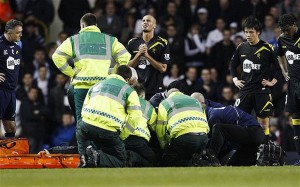By Dr. Khine Win
Sport and Exercise Medicine: The UK trainee perspective (A twice-monthly Guest Blog)
I recently had the honour of assisting with cardiac screening in a dance company and an academy football team. I came across many concerned parents and athletes. Some refused to participate in screening tests. Some even attempted to hide their family history, including a heart attack at a young age.

One of the parents had suffered a heart attack when he was 27 years old. He asked me when his son, who was 9 years old, would need to start screening. One parent also asked, since Fabrice Muamba underwent cardiac screening and still collapsed, how effective, really, are the screening processes.
If any of the results turned out to be abnormal, would the person be treated or protected from SCD?
Or would the club be informed of the results and the players be disqualified from their sport?
These were valid million-pound questions, which made me wonder.
I recalled my time at Liverpool Heart and Chest Hospital, when I was part of the team performing family screening for rare cardiac diseases. Even after extensive tests, some of the results remained uncertain, leading to psychological disturbances in patients. One of my patients with suspected Brugada syndrome told me that she had stopped doing anything physical because of the worry of sudden death.
As a Sport and Exercise Medicine trainee, managing “Sudden Cardiac Death” was one of the competencies in our training curriculum. I hope to have gained this competency through training, background reading and practical involvement. Notwithstanding, in ‘real world’ scenarios, many uncertainties still exist.
Background literature
Sudden Cardiac Death (SCD) or Sudden Cardiac Arrest (SCA) is defined as an event that is non-traumatic, unexpected, and resulting from sudden cardiac arrest within six hours of previously witnessed normal health without other explanation. (Sharma et al. BJSM 1997)
Common Etiology
The most common cause of SCA in older athletes (>35 years) is unsuspected coronary artery disease but in the younger group inherited or congenital cardiac disorders are more common. (Sharma et al. BJSM 2012)
Causes of SCA can be widely variable.
Inherited/Congenital causes
- Myocardial diseases (Hypertrophic Obstructive Cardiomyopathy, Arrthymogenic Right Ventricular Cardiomyopathy)
- Valvular diseases (such as Aortic root dilatation, aortic stenosis etc)
- Coronary artery pathologies (congenital anomalies, spasm, dissection, vasculitis etc)
- Conduction system (such as Wolff-Parkinson-White syndrome, long QT)
- Ion Channelopathies (eg: Brugada)
Acquired conditions (such as infection, myocarditis, drugs, electrolytes imbalance, blunt trauma etc)
Screening
In Italy, cardiac screening has been compulsory since 1982 in all athletes participating in competitive sports. To prevent one SCD, over 500 athletes are disqualified. Many other European countries also offer Cardiac screening but it is not compulsory. In the UK, screening for heart disease is still not fully funded in the NHS and is provided by charities such as Cardiac Risk in the Young (CRY)
FIFA made the pre-competition medical assessment mandatory for all FIFA competitions and recently initiated the establishment of a database for SCA/SCD for all 208 Member Associations to obtain more information. (Weiler et al. BJSM 2012)
SCA is rare but can be highly traumatic. It usually attracts a lot of media attention and may negatively impact the public view on sport and physical activity.
Improving Protocols
There is a need to establish a Central or National data registry on all SCA/SCD across sport and encourage research using this data to develop a robust and practical screening program.
Meanwhile it is essential to ensure the availability of defibrillators at all stadiums, accessibility of appropriately trained medical professionals across sport, and increasing public and athletes awareness and understanding on heart screening.
And finally pray that you never come across SCD/SCA in any sports team or sporting event that you cover throughout your career.
Related BJSM blogs
A South African Perspective on AEDs
Sudden Cardiac Death screening: notes of caution
Call for NHS to review its policy on screening of young people at risk of sudden cardiac death
ECG Summit in Seattle: Successes and Next Steps
References
- Ghani S, Sharma S: Pre-participation cardiovascular screening in athletes: when and how. Cardiovascular Medicine 2012;15(1):7–13
- Sharma S, Ghani S, Papadakis M. ESC criteria for ECG interpretation in athletes: improved but not replete. Heart. 2011;97:1540–1
- Weiler R, Goldstein MA, Beasley I, Drezner J, Dvorak J: What can we do to reduce the number of tragic cardiac events in sport? Br J Sports Med 2012 46: 897-898
- Thompson PD: Preparticipation Screening of competitive athletes Seeking simple solutions to a complex problem. Circulation. 2009;119:1072-1074
***************************************************
Dr. Khine Win is a Specialty Registrar in Sport and Exercise Medicine, West Midlands deanery.
Dr James Thing co-ordinates “Sport and Exercise Medicine: The UK trainee perspective” monthly blog series.